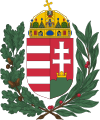Ferenc Keresztes-Fischer | |
|---|---|
 | |
| Minister of the Interior of Hungary | |
| In office 24 August 1931 – 4 March 1935 | |
| Preceded by | Béla Scitovszky |
| Succeeded by | Miklós Kozma |
| In office 14 May 1938 – 22 March 1944 | |
| Preceded by | József Széll |
| Succeeded by | Andor Jaross |
| Personal details | |
| Born | 18 February 1881 Pécs, Austria Hungary |
| Died | 3 March 1948 (aged 67) Vienna, Austria |
| Political party | Christian National Union Party Unity Party Party of National Unity Party of Hungarian Life |
| Spouse | Margit Rihmer |
| Parent(s) | Ferenc Fischer Margit Krasznay de Kraszna |
| Relatives | Lajos Keresztes-Fischer (brother) |
| Profession | politician |
Ferenc Keresztes-Fischer (18 February 1881 – 3 March 1948) was a Hungarian lawyer and politician. He was an advisor of the Pécsi Takarékpénztár Rt. / Pécs Savings Bank Corp. He was the prefect of Baranya County 1921–1931, and the prefect of Somogy County 1925–1931 and was appointed as Interior Minister of Hungary twice; between 1931–1935 and 1938–1944. He controlled the police terror against both the left and right wing political movements. In a secret directive he ordered the collection of Press articles.(?) On 12 September 1938, he allowed the OMIKE to increase its activities. During the Second World War he was an active supporter of the Regent, Admiral Miklós Horthy. After the death of Pál Teleki (3 April 1941) Keresztes-Fischer became acting Prime Minister on that day.[1] One year later, On March 7, 1942, Bárdossy the prime minister was forced to resign suddenly by Regent Horthy and as Minister of the Interior, Ferenc-Keresztes was the interim Prime Minister until 9 March, when Miklós Kállay was appointed to this position.[2]
He joined the Bethlen-Kállay political conservatives, which wanted to establish contacts with the Allies to negotiate Hungary's treatment after the war. After the March 1944 occupation of Hungary by Nazi Germany, he was imprisoned in a concentration camp and then exiled to Austria.
His younger brother was Lajos Keresztes-Fischer, a Hungarian military officer who served as Chief of General Staff in 1938. He was also arrested after Ferenc Szálasi's coup.[3]
See also[edit]
References[edit]
- ^ Bölöny – Hubai 2004, p. 29.
- ^ Bölöny – Hubai 2004, p. 29.
- ^ Magyar Katolikus Lexikon – Hadtörténeti Közlemények 1984/2:386.
Sources[edit]
- Magyar Életrajzi Lexikon
- Bölöny, József – Hubai, László: Magyarország kormányai 1848–2004 [Cabinets of Hungary 1848–2004], Akadémiai Kiadó, Budapest, 2004 (5th edition).
- Akten des Volksgerichtsprozesses gegen Franz A. Basch, Volksgruppenführer der Deutschen in Ungarn, Budapest 1945/46, Friedrich Spiegel-Schmidt, Lóránt Tilkovszky, Gerhard Seewann, Norbert Spannenberger, Oldenbourg Wissenschaftsverlag 1999.
